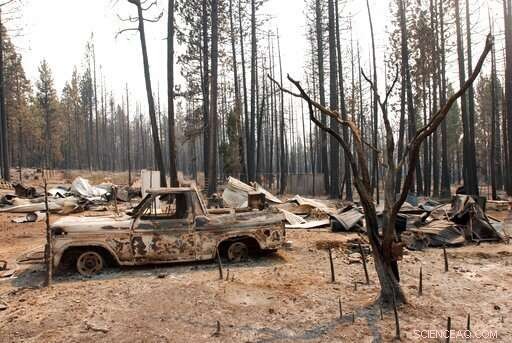
In questo mercoledì, 22 agosto 2012, foto d'archivio, un camion danneggiato si trova tra gli altri resti in una casa rurale fuori Manton, California, dove un enorme incendio ha bruciato sabato, costringendo i residenti ad evacuare. Un'analisi di McClatchy rivela più di 350, 000 californiani vivono in paesi e città che esistono quasi interamente all'interno di "zone a rischio di incendio molto elevato". (Foto AP/Jeff Barnard, File)
Città impoverite all'ombra del monte Shasta. Città rustiche della corsa all'oro ai piedi della Sierra Nevada. Comunità di resort ad alto prezzo sulle rive del lago Tahoe. Ritzy periferia della contea di Los Angeles.
Potrebbero essere tutti il prossimo Paradiso.
Un'analisi di McClatchy rivela più di 350, 000 californiani vivono in paesi e città che esistono quasi interamente all'interno di "zone a rischio di incendio molto elevato", la designazione di Cal Fire per luoghi altamente vulnerabili a incendi devastanti. Queste designazioni si sono dimostrate stranamente predittive su alcuni degli incendi boschivi più distruttivi dello stato negli ultimi anni, compreso il fuoco da campo, il peggiore nella storia dello stato.
Quasi tutto il Paradiso è colorato in rosso vivo sulla mappa di Cal Fire:praticamente l'intera città era a grave rischio prima che il fuoco di campo infuriasse lo scorso novembre, bruciando la maggior parte delle case sul suo cammino e uccidendo 85 persone.
Malibu, dove il Woolsey Fire ha bruciato più di 400 case l'anno scorso, rientra anche in zone a rischio molto elevato. Così come la cittadina di Cobb, nella contea di Lake, gran parte del quale è stato distrutto dall'incendio della valle nel 2015.
"Ci sono molti paradisi là fuori, " ha detto Max Moritz, uno specialista antincendio presso l'UC Santa Barbara.
Tutto detto, più di 2,7 milioni di californiani vivono in zone a rischio di incendio molto elevato, dai rimorchi su tranquille strade sterrate nella foresta alle ville nelle più grandi città dello stato, secondo l'analisi, che si basa sui dati del censimento a livello di blocco del 2010. Il Dipartimento delle foreste e della protezione antincendio della California afferma che le sue mappe mostrano luoghi in cui è probabile che gli incendi siano estremi a causa di fattori tra cui la vegetazione e la topografia.
Le mappe non sono perfette nella loro capacità di prevedere dove un incendio sarà distruttivo. Ad esempio, il quartiere Coffey Park di Santa Rosa non è in una zona ad alto rischio, ma venti potenti spinsero il fuoco di Tubbs in quella parte della città, livellando in gran parte il quartiere nell'ottobre 2017.
Coffey Park è stato costruito "senza considerare il fuoco, " ha detto Chris Dicus, un esperto di selvicoltura e fuoco a Cal Poly San Luis Obispo. "Il fuoco era in montagna, non c'era alcuna considerazione che il fuoco avrebbe attraversato (autostrada) 101."
Cal Fire sta realizzando nuove mappe del rischio di incendio, pronte tra circa un anno, che incorporeranno i modelli regionali del vento e altri fattori climatici. Intanto, gli esperti dicono che le mappe attuali, creato circa un decennio fa, forniscono comunque una guida importante per prevedere dove gli incendi potrebbero causare i maggiori danni, allo stesso modo le mappe delle pianure alluvionali evidenziano le aree che potrebbero essere colpite più duramente durante forti tempeste.

In questo 14 marzo, 2019, foto, un complesso residenziale al largo di Chief Kelly Drive a Nevada City, California, è in costruzione. Le città della California continuano a costruire case in aree ad alto rischio di incendi. I funzionari della città concordano sul fatto che il bosco disegna, pendii scoscesi, strette vie residenziali, case antiche e fitte chiome di alberi urbani che definiscono il carattere della città la rendono inoltre particolarmente a rischio se un incendio divampa. (Hector Amezcua/The Sacramento Bee via AP)
Le comunità a rischio identificate da McClatchy dovrebbero anche servire come punto di partenza per dare la priorità a come la California dovrebbe spendere soldi per retrofit e altri programmi di sicurezza antincendio, disse Moritz.
I codici edilizi all'avanguardia della California aiutano a proteggere le case dagli incendi boschivi nelle aree più vulnerabili, dicono gli esperti. Ma i codici si applicano solo alle nuove costruzioni. Un disegno di legge presentato dal membro dell'Assemblea Jim Wood fornirebbe denaro per aiutare i californiani a ristrutturare le vecchie case.
"Questo andrà molto avanti verso questi diversi comuni (nel dimostrare) che meritano finanziamenti, " ha detto Moritz.
McClatchy ha identificato più di 75 paesi e città con una popolazione superiore a 1, 000 dove, come il paradiso, almeno il 90% dei residenti vive all'interno delle "zone a rischio di incendio molto elevato" di Cal Fire.
Ecco le istantanee di 10, e le sfide uniche che devono affrontare:
___
Shingletown:un paradiso in miniatura
Popolazione (2010)—2, 283 ' In zona di gravità a rischio di incendio molto elevato—2, 283
Shingletown è grande meno di un decimo di Paradise, ma probabilmente comporta lo stesso rischio.
come il paradiso, la comunità non incorporata siede in cima a un crinale, ed è coperto da alberi ad alto fusto e fitta boscaglia, ingredienti per un grande incendio. Shingletown era originariamente chiamato Shingle Camp, per i lavoratori che tagliavano le lamelle del tetto dal legname per rifornire i minatori durante l'era della corsa all'oro.

In questo 14 marzo, 2019, foto, il centro di Nevada City è circondato da una fitta area boschiva, che ne aumenta il rischio di incendio. I funzionari della città concordano sul fatto che il bosco disegna, pendii scoscesi, strette vie residenziali, case antiche e fitte chiome di alberi urbani che definiscono il carattere della città la rendono inoltre particolarmente a rischio se un incendio divampa. (Hector Amezcua/The Sacramento Bee via AP)
"Coltiviamo alberi come se non fossero affari di nessuno quassù, " ha detto Tom Twist, un membro del Shingletown Fire Safe Council, un'organizzazione di volontariato. Intrecciare, che ha vissuto nella comunità di tanto in tanto dagli anni '70, ha detto che quando fa caldo passerà per la sua proprietà, tirare su piantine in uno sforzo quasi inutile per eliminare potenziali combustibili.
"Tirerò da terra 20 o 30 piantine al giorno, " ha detto. "E 'quasi come quando cammino laggiù, ce ne sono 20 o 30. Quando torno indietro, ce ne sono altri 20 o 30".
Proprio come il paradiso, fuggire dalla cresta in un fuoco in rapido movimento non sarebbe stato facile; La via principale di Shingletown è tortuosa, stretta autostrada 44. E, come in paradiso, la presenza di una popolazione anziana renderebbe più difficile l'evacuazione; L'età media di Shingletown è 61 anni, secondo i dati del censimento.
Non c'è da meravigliarsi se quando il governatore Gavin Newsom ha ordinato a Cal Fire di sviluppare un elenco di progetti urgenti di sicurezza antincendio, un piano per tagliare 1, 124 acri di vegetazione lungo la Highway 44 sono stati la priorità assoluta su 35 progetti in tutto lo stato.
La gente del posto dice di essere contenta che lo stato presti attenzione a un problema che conoscono troppo bene. La comunità ha dovuto evacuare quando l'incendio di Ponderosa, iniziato da un fulmine, colpito nel 2012. Il fuoco ha bruciato 27, 676 acri, 43 miglia quadrate, e 52 case incendiate nelle vicinanze.
"Siamo intimamente consapevoli dei pericoli quassù, " ha detto Twist.
___
Nevada City:pittoresca e rischiosa
Popolazione (2010)—3, 068 ' In zona a rischio di incendio molto elevato—3, 064
Dal fuoco del campo, Vicky Guyette ha considerato l'area di un acro di cespugli non tagliati dietro la casa di epoca vittoriana di sua madre a Nevada City come qualcosa di più di un semplice fastidio.

In questo 24 marzo 2019, foto, Gene Mapa raccoglie oggetti in metallo e ceramica che non hanno bruciato nel fuoco da campo nella sua casa in Paradiso, California Mapa ora vive a Colfax, che come un livello simile di rischio di incendio. Un ex hub di approvvigionamento per i campi di estrazione dell'oro, Colfax si trova a poche miglia dal confine della Tahoe National Forest nella Sierra a bassa quota. Si trova a cavallo dell'Interstate 80 e funge da ultima tappa importante tra l'area metropolitana di Sacramento e la regione del Lago Tahoe. I cavalli pascolano accanto ai cervi su grandi ranchette negli aspri canyon cespugliosi lungo la periferia della città. (Hector Amezcua/The Sacramento Bee via AP)
Ora, il pennello è inquietante:una fonte di accensione che potrebbe incendiare la casa costruita nel 1859 in cui la sua famiglia vive da cinque generazioni.
La stessa ansia vale anche per i cedri, pini e cespugli che ricoprono le colline intorno a questa città pedemontana di circa 3, 100 persone, molti dei quali vivono o lavorano in edifici in legno risalenti all'era della corsa all'oro.
"È molto spaventoso, soprattutto perché è una cittadina così carina in cui ho vissuto tutta la mia vita, " Guyette ha detto di recente mentre camminava lungo la storica Broad Street della città, che sembra uscito da una foto di una mostra museale.
I funzionari della città concordano sul fatto che il bosco disegna, pendii scoscesi, strette vie residenziali, case antiche e fitte chiome di alberi urbani che definiscono il carattere della città la rendono inoltre particolarmente a rischio se un incendio divampa.
"Il più grande rischio per la vita umana e la perdita finanziaria della città del Nevada è il fuoco, "Si legge nel piano di mitigazione dei rischi di Nevada City.
Negli ultimi decenni, la città ha anche avuto alcuni incidenti sfiorati con il fuoco, compreso un importante incontro ravvicinato.
Nel 1988, forti venti hanno spinto il 49er Fire attraverso 52 miglia quadrate della contea occidentale del Nevada, bruciando 312 edifici e decine di automobili.
"All'epoca era considerato un evento anomalo, " ha detto Billy Spearing del Fire Safe Council della Contea del Nevada. "Allora non era normale per loro."
Con tali incendi che diventano la nuova normalità, Cal Fire sta pianificando di tagliare un 1, 802 acri tagliafuoco nel sud-ovest della contea del Nevada in un terreno che non brucia da un secolo, aiutando a proteggere sia Nevada City che l'adiacente comunità di Grass Valley, ospita più di 12 persone, 000.
Nevada City ha anche avviato una campagna online "Goat Fund Me" per raccogliere $ 25, 000 ad assumere agricoltori per usare le loro capre per mangiare fitti cespugli in più di 450 acri di cintura verde di proprietà della città.
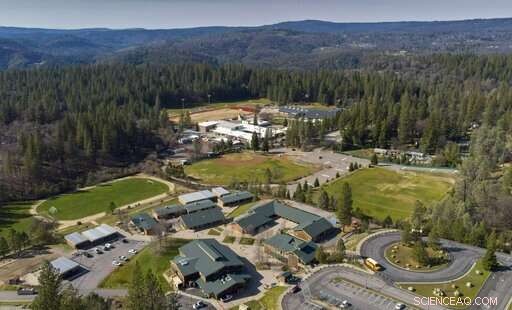
In questo 14 marzo 2019, foto, Colfax, Calif.'s elementary and high schools are surrounded by trees but could become a safe zone in the event of a wildfire similar to the one that destroyed Paradise. A former supply hub for gold mining camps, Colfax sits a few miles from the edge of the Tahoe National Forest in the lower-elevation Sierra. It straddles Interstate 80 and serves as the last major stop between the Sacramento metropolitan area and the Lake Tahoe region. Horses graze beside deer on large ranchettes in the rugged brushy canyons along the outskirts of the city. (Hector Amezcua/The Sacramento Bee via AP)
The goats recently chewed a swath through Pioneer Park near Margaret Rodda's Victorian home, which sits on a steep draw above a creek. But she's still worried.
"All it takes is a drunk with a cigarette, " lei disse.
The goats inspired Guyette. She said she might spend the $500 to put a herder's goats to work on the thorny thicket of blackberries behind her mother's house.
"We need to get rid of them, " lei disse.
__
Colfax:Fire is on everyone's minds
Population (2010)—1, 963 ' In Very High Fire Hazard Severity Zone —1, 963
On his first full day in office, Newsom visited the Cal Fire station in Colfax to announce new initiatives on wildfire safety. As he spoke to reporters, surrounded by first responders, he was standing in a city that could burn any summer.
"The people who live here have a true understanding, " said Colfax City Manager Wes Heathcock. "It's always on the back of people's minds, especially with the most recent fires, the Camp Fire. We have a similar makeup here."
At night in the summer, Aimee Costa, who lives on a hill above the elementary school, sometimes keeps her window open, the better to hear ominous sounds.

In this 2007 photo, men clear debris after the Angora Fire destroyed hundreds of Tahoe-area homes south of Kings Beach, Calif. Situated on the pristine north shore of Lake Tahoe, Kings Beach is one of the most heavily visited vacation spots in Northern California. That's a big part of the problem. Because so much of the population comes and goes, it becomes harder to get people to treat wildfire risk with the respect it deserves. (Paul Kitagaki Jr./The Sacramento Bee via AP)
"You're laying in bed . listening for that lick, that smack, that pop sound, " Costa said, describing the sound flames would make if they were chewing pine needles, brush and leaves.
A former supply hub for gold mining camps, Colfax sits a few miles from the edge of the Tahoe National Forest in the lower-elevation Sierra. It straddles Interstate 80 and serves as the last major stop between the Sacramento metropolitan area and the Lake Tahoe region. Horses graze beside deer on large ranchettes in the rugged brushy canyons along the outskirts of the city.
The terrain poses a major fire risk.
In July 2015, the Lowell Fire erupted near Colfax and chewed up thousands of acres along the north side of the freeway, forcing evacuations in adjacent Nevada County. In the years since, Heathcock said the city has been working with state officials on "fuelbreak" projects, including a spot near the high school and elementary school, which has been eyed as an evacuation site.
Gene Mapa, who lived in Paradise and escaped the Camp Fire with some family photographs—and nothing else—has relocated to Colfax, where he already owned a second home. But he knows he hasn't escaped the fire risk; his property just outside the city limits would be threatened by a windy firestorm like the one that engulfed Paradise.
"With that wind, there would be no stopping it anywhere, " Mapa said.
__
Kings Beach:Tourists seek fun, bring fire danger
Population (2010)—3, 796 ' In Very High Fire Hazard Severity Zone —3, 796
Situated on the pristine north shore of Lake Tahoe, Kings Beach is one of the most heavily visited vacation spots in Northern California.

In this Sept. 15, 2014, foto d'archivio, a jet drops a load of fire retardant near Highway 50 in El Dorado County near Pollack Pines, Calif. Memories are still vivid of the Sand Fire in 2014. That fire burned 4, 200 acres and 20 homes and came dangerously close to forcing a major evacuation in Pollock Pines and surrounding communities. (Randy Pench/The Sacramento Bee via AP)
That's a big part of the problem.
Because so much of the population comes and goes, it becomes harder to get people to treat wildfire risk with the respect it deserves, said Erin Holland, a spokeswoman for the North Tahoe Fire Protection District. One of the district's six stations is in Kings Beach.
"It is definitely a challenge because we have so many homes that are vacation homes, " she said. "It's really a challenge to educate those visitors . They want to have a camp fire."
Tahoe's vulnerability to major fires was brought home dramatically in recent years. The Angora Fire in 2007, while it was confined to the south shore area, left physical and emotional scars on the entire basin after burning through 3, 100 acres.
Holland said getting the region's property owners and visitors to observe "defensible space" regulations is particularly difficult. Those rules call for clearing brush 100 feet around buildings and include stricter rules regarding vegetation immediately adjacent to structures.
Violators can be subject to citations, but "the goal is to really educate people, to get people complying, " Holland said. "We go the education route rather than the citation route."
__
Pollock Pines:Do the transplants get it?
Population (2010)—6, 877 ' In Very High Fire Hazard Severity Zone—6, 533
Just off Highway 50, a few miles from the tourist haven of Apple Hill, Pollock Pines lures transplants from coastal California, mainly retirees drawn to the lovely stands of trees in the foothill community at the edge of the Eldorado National Forest.
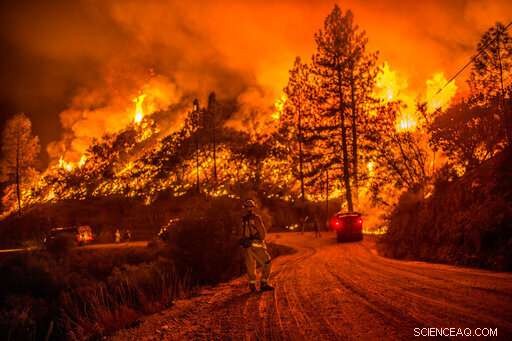
In this 2015 photo, fire crews run controlled burns at night to contain the Butte Fire near Arnold, Calif. In the community that serves as gateway to Calaveras Big Trees State Park, residents didn't always applaud when officials began mapping plans to thin dense stands of trees to reduce fire risk. "Arnold resisted this for a long time because people love their trees, " said Steve Wilensky, a former Calaveras County supervisor who works with nonprofits to improve fire safety in the Sierra. (Andrew Seng/The Sacramento Bee via AP)
Heather Campbell only wishes the newbies had a better understanding of what all that timber represents.
Campbell, a retired U.S. Forest Service employee who's lived in Pollock Pines since the 1990s, is the head of the Pollock Pines-Camino Fire Safe Council, a volunteer group.
In the past few years her organization has received hundreds of thousands of dollars in grants, mainly from the state's "cap and trade" carbon trading program, to trim vegetation on the ridgeline south of Highway 50.
That's all well and good, lei disse, but more needs to be done. And the people of Pollock Pines, including the newcomers, have to realize what's at stake.
"Here, everybody allows all the saplings and brush to grow and they don't weed it out, " she said. "All these roads are incredibly dangerous, when it's so easy to take out pruners. Take out your pruners!"
She said memories are still vivid of the Sand Fire in 2014. That fire burned 4, 200 acres and 20 homes and came dangerously close to forcing a major evacuation in Pollock Pines and surrounding communities.
"They were going to evacuate 9, 000 persone, " she said. "They were predicting the fire to go to 27, 000 acri, instead of the 4, 000 they stopped it at."
__
Arnold:Trees are falling in Big Trees country
Population (2010)—3, 843 ' In Very High Fire Hazard Severity Zone—3, 843

In questo lunedì, Aug. 18, 2014, foto d'archivio, smoke rises from a fire in Wofford Heights, Calif. The same powerful desert gusts that attract wind surfers to Kern County's Lake Isabella make the lakeside community of Wofford Heights particularly at risk for wildfire. So does the adjacent Sequoia National Forest, which has been plagued by drought and tree-killing beetles. (Casey Christie/The Bakersfield Californian via AP, File)
In the community that serves as gateway to Calaveras Big Trees State Park, residents didn't always applaud when officials began mapping plans to thin dense stands of trees to reduce fire risk.
"Arnold resisted this for a long time because people love their trees, " said Steve Wilensky, a former Calaveras County supervisor who works with nonprofits to improve fire safety in the Sierra.
After years of protests, Arnold's residents got a major wake-up call in 2015. The Butte Fire, caused by power lines, took out 549 homes in nearby communities. Two people died.
"If the weather hadn't changed, they'd be gone, " Wilensky said of Arnold. "You've got a real parallel with Paradise in some ways . It's a place that is really highly threatened."
Arnold sits on a ridge, surrounded by a dense forest of drought- and beetle-killed trees. Powerful wind gusts can funnel fire up rugged brushy canyons.
A key difference between Paradise and Arnold is that as many as 45 percent of the dwellings are vacation homes, which can sometimes make it a challenge to get out-of-town homeowners to do brush clearing, hanno detto i funzionari locali.
Wilensky said momentum to reduce fire risk has built since the Butte Fire. More than $15 million in state and federal funds have gone to thinning dangerous overgrowth in the region, Wilensky said.
One project includes using bulldozer lines that were cut during the Butte Fire to expand a fire break that stretches to town.
"Arnold is the anchor end of this project, " Wilensky said.
__
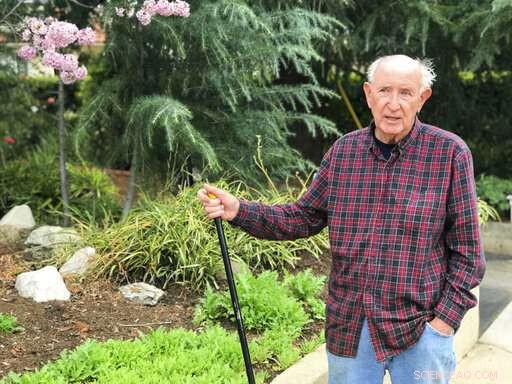
In this March 20, 2019, foto, Thomas Caswell talks about living on his La Canada Flintridge street for four decades. He said he loves his community, but he has no illusions about the threat of a fire funneling down from the nearby Angeles National Forest. "When it comes down the hill, " Egli ha detto, "nobody is going to be safe." (Ryan Sabalow/The Sacramento Bee via AP)
Wofford Heights:Apathy in a danger zone?
Population (2010)—2, 201 ' In Very High Fire Hazard Severity Zone—2, 147
The same powerful desert gusts that attract wind surfers to Kern County's Lake Isabella make the lakeside community of Wofford Heights particularly at risk for wildfire. So does the adjacent Sequoia National Forest, which has been plagued by drought and tree-killing beetles.
Yet some feel that the region isn't doing nearly enough to combat the threat.
"We could do a hell of a lot more than we're doing, " said Judy Hyatt, who lived in the area for 15 years and served as president of the region's fire safe council. The volunteer group disbanded in recent years from what she and others described as a lack of interest.
Nel 2016, the Lake Isabella region suffered through the Erskine and Cedar fires, which burned more than 77, 000 acres and more than 300 structures. An elderly couple was killed when they were trapped by the Erskine Fire.
According to census figures, the median age of those living in Wofford Heights is 62, and many live in places with poor escape routes.
"Some of those mobiles up there, honest to God, I think they've dropped them out of the sky, " Hyatt said. "The roads are so narrow, and it really just presents an obstacle and the only way to really get to it is by air. That is when people start to die."
Hyatt said the loss of the nonprofit Kern River Fire Safe Council she once headed doesn't bode well for the community. She said the council organized wood-chipping drives to encourage residents to remove wood debris and sought grants for fuel breaks and other thinning projects.
She said too many locals have grown complacent.

In questo lunedì, 22 agosto 2016, foto d'archivio, workers cut brush off Highway 155, west of Wofford Heights, California, as part of fuel reduction for the Cedar Fire. The same powerful desert gusts that attract wind surfers to Kern County's Lake Isabella make the lakeside community of Wofford Heights particularly at risk for wildfire. So does the adjacent Sequoia National Forest, which has been plagued by drought and tree-killing beetles. (Casey Christie/The Bakersfield Californian via AP, File)
"Fire prevention is a nebulous thing, " she said. "It's hard to quantify, until there's a damned fire that takes out everything."
__
La Cañada Flintridge:Is aggressive fire prevention enough?
Population (2010)—20, 048 ' In Very High Fire Hazard Severity Zone—20, 048
Carol Settles and her family evacuated their home in La Cañada Flintridge during the Station Fire in 2009. But she isn't terribly worried about a repeat performance—even though her home is on a dead-end street below a brushy hillside of the Angeles National Forest. Large electrical transmission lines run along the wooded draw behind her home.
"We've never seen a spark, " Settles said, referring to the power lines. "We've never seen any of that."
Best-known as home to NASA's Jet Propulsion Laboratory on the outskirts of Pasadena, the upper middle-class city has an aggressive fire-prevention program. The Los Angeles County fire department checks properties in Settles' area once a year to make sure vegetation has been cleared and hazardous landscaping hasn't been planted.
Fines can be issued for non-compliance. Recentemente, one of Settles' neighbors had to saw off the top of a pine tree because it was too close to a transmission tower, lei disse.
Los Angeles County's assistant fire chief, J. Lopez, said La Cañada Flintridge has embraced rigorous fire-safety standards, which include annual landscaping inspections and stringent fire-safe building codes, even for large home remodels. Lopez said La Cañada Flintridge also chose to place the entire city inside a high fire hazard zone, going beyond the recommendation of Cal Fire. That decision translates into citywide enforcement of its fire-resilient building codes.
"That's a very progressive way to look at it, " Lopez said.

In this March 22, 2019 foto, a newer home sits along a ridge above Harbison Canyon in San Diego County, Calif. Every 30 years or so, a massive fire blows through Harbison Canyon, 30 miles northeast of San Diego. The 1970 Laguna Fire destroyed much of the unincorporated town that sits inside the canyon and shares its name. Harbison Canyon was rebuilt again after the Cedar Fire burned through in 2003, destroying 287 of the 388 homes. (Ryan Sabalow/The Sacramento Bee via AP)
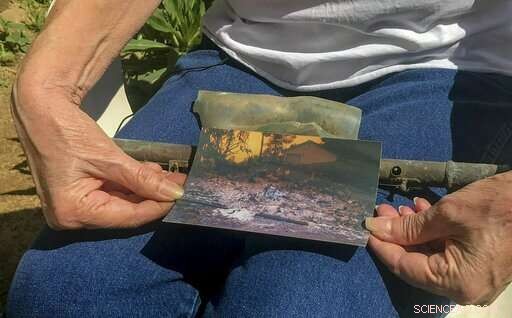
In this March 22, 2019, foto, Cheri Skipper, a Harbison Canyon resident, holds her burned flute and a picture showing what her home looked like after it burned during the Cedar Fire in 2003. Every 30 years or so, a massive fire blows through Harbison Canyon, 30 miles northeast of San Diego. The 1970 Laguna Fire destroyed much of the unincorporated town that sits inside the canyon and shares its name. Harbison Canyon was rebuilt again after the Cedar Fire burned through in 2003, destroying 287 of the 388 homes. (Ryan Sabalow/The Sacramento Bee via AP)
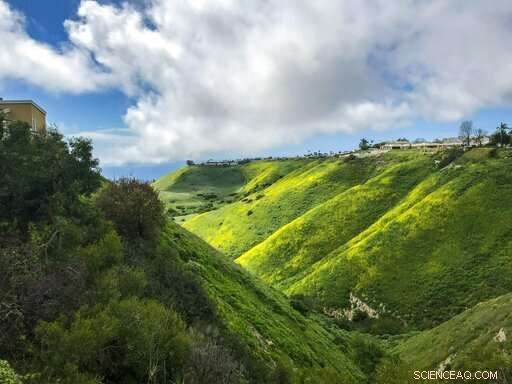
In this March 21, 2019, foto, homes line one of the canyons in Rancho Palos Verdes, Calif. The many acres of open space in the city provide breathtaking views and public access to wild places between city subdivisions, but the vegetation poses a substantial fire risk. Rancho Palos Verdes holds a dubious honor:It's the most populated city in California to have 90 percent or more of its population living within a "very high fire hazard severity zone." (Ryan Sabalow/The Sacramento Bee via AP)/The Sacramento Bee via AP)

In questo lunedì, Aug. 20, 2012, foto d'archivio, a DC-10 drops fire retardant on the Ponderosa Fire near Paynes Creek, Calif. A McClatchy analysis reveals more than 350, 000 Californians live in towns and cities that exist almost entirely within "very high fire hazard severity zones." (Andreas Fuhrmann/The Record Searchlight via AP, File)

In questo martedì, Nov. 4, 2003, foto d'archivio, President George W. Bush views fire damage with San Diego County supervisor Dianne Jacob during a tour of Harbison Canyon, outside of San Diego. Every 30 years or so, a massive fire blows through Harbison Canyon, 30 miles northeast of San Diego. The 1970 Laguna Fire destroyed much of the unincorporated town that sits inside the canyon and shares its name. Harbison Canyon was rebuilt again after the Cedar Fire burned through in 2003, destroying 287 of the 388 homes. (AP Photo/Charles Dharapak, File)
But since 2008, on average only about a dozen new homes have been built in La Cañada Flintridge each year, meaning most of the housing stock was built before the rigorous fire standards were in place.
The city's hazard mitigation plan notes many of those older homes still have "combustible roofing, open eaves, combustible siding, " and they're on "steep, narrow, poorly signed" roads that make evacuations dangerous.
Thomas Caswell, who's lived for four decades on a hilly, narrow, dead-end street not far from city hall, said he knows the greenbelt behind his house where he watches possums, birds and other wildlife also makes the community vulnerable to fire. It's why he says he didn't mind paying when the city told him he needed to hire a tree service to remove dying trees in his front yard.
Ancora, he knows such efforts probably wouldn't do much good if the Santa Ana winds pushed a fire into the city. Fire officials said that La Cañada Flintridge could have burned in the Station Fire if the Santa Ana winds hadn't stopped blowing. The fire burned 89 homes in outlying communities and 160, 577 acres of forested lands, the largest fire by land mass in Los Angeles County history.
"Once it comes down the hill, " Caswell said, "nobody is going to be safe."
__
Rancho Palos Verdes:Few fears in an affluent suburb
Population (2010)—41, 803 ' In Very High Fire Hazard Severity Zone—40, 550
Rancho Palos Verdes holds a dubious honor:It's the most populated city in California to have 90 percent or more of its population living within a "very high fire hazard severity zone." But few residents seem to think their suburb is in the same league as Malibu, where hundreds of homes burned last fall just up the Los Angeles County coastline.
"It's not like living in Malibu, definitely, " said Gregory Lash as he strolled through a public access walkway in the Trump National Golf Club with his wife, Vivian, on the way to an oceanside park where a pod of dolphins and whales were breaching.

In this March 21, 2019, foto, Michael Choi, the owner of Fire Grazers Inc., adjusts a goat pen in Rancho Palos Verdes, California, on a rainy day. The city paid Choi $100, 000 for his goats to eat vegetation on about 60 acres over the course of three months. The goats reduce fire risks around homes. Rancho Palos Verdes holds a dubious honor:It's the most populated city in California to have 90 percent or more of its population living within a "very high fire hazard severity zone." (Ryan Sabalow/The Sacramento Bee via AP)
Ha aggiunto, moments later:"Hope that's not naive."
City officials say it's not.
"This being a coastal community, we don't get the type of brush and that kind of fire behavior that you might get in somewhere like Paradise, " said Scott Hale, an assistant fire chief for Los Angeles County. The county leads firefighting efforts on the Palos Verdes Peninsula, whose four affluent communities all fall inside a high fire severity zone.
Locals point out that over the years, the firefighters at the five stations on the peninsula have quickly knocked down the relatively small fires that popped up.
Ancora, Rancho Palos Verdes' hazard mitigation plan lists wildfire as a bigger threat to the city than earthquakes, tsunami e frane. Powerful winds that blow from the coast could funnel a fire up the greenbelts that cut through the peninsula's neighborhoods, many of which have opulent homes perched above canyons.
Much of that open space has been preserved by the Palos Verdes Peninsula Land Conservancy, which manages more than 1, 600 acres of land in and around the city. Residents such as Lash love the 42 miles of trails on conservancy lands, but all that undeveloped acreage could ignite, said Gabriella Yap, deputy city manager.
"You're trying to preserve that, but it also comes with fire risk, " Yap said.
The city's staff supports Southern California Edison's plans to trim vegetation from under the lines that run through some of the open space to reduce fire threats, but the land conservancy is bristling at the loss of native habitats.
"The environmental impact of that is really significant, " said Adrienne Mohan, the conservancy's executive director.
__

In this March 21, 2019, foto, Adrienne Mohan, the executive director of the Palos Verdes Peninsula Land Conservancy, stands above acreage her organization maintains in Rancho Palos Verdes, Calif. Rancho Palos Verdes holds a dubious honor:It's the most populated city in California to have 90 percent or more of its population living within a "very high fire hazard severity zone." But few residents seem to think their suburb is in the same league as Malibu, where hundreds of homes burned last fall just up the Los Angeles County coastline. (Ryan Sabalow/The Sacramento Bee via AP)
Harbison Canyon:Will it burn a third time?
Population (2010)—3, 841 ' In Very High Hazard Fire Severity Zone—3, 841
Every 30 years or so, a massive fire blows through Harbison Canyon, 30 miles northeast of San Diego.
The 1970 Laguna Fire destroyed much of the unincorporated town that sits inside the canyon and shares its name. Harbison Canyon was rebuilt again after the Cedar Fire burned through in 2003, destroying 287 of the 388 homes.
Rick Halsey of the Chaparral Institute said the canyon is a painful example of how development has been allowed to continue practically unchecked for decades into some of California's most fire-prone places.
"You want to create a geographical hotspot for fire, you couldn't put it in a better place, " said Halsey, whose environmentalist organization was founded to fight calls for clearing hundreds of square miles of wild lands following the Cedar Fire. "It's like a bowling alley for the Santa Ana winds."
That sort of talk makes longtime resident Mary Manning cringe.
She worries that focusing on the canyon's fire risk creates the impression that the community she loves can't be saved from the next catastrophe. She said her community could be made more safe if state and local officials would invest in infrastructure and fire prevention that matched the rates of development she's seen over the years. Ad esempio, the side streets in Harbison Canyon are narrow. Alcuni, like Manning's, remain unpaved despite decades of building.
"There were five houses, now there are 35, " she said of the street she's lived on since 1975.
Manning notes it was only two years ago that the local fire station became staffed 24 hours a day—14 years after the Cedar Fire. Inside the station, Dave Nissen, the Cal Fire official who oversees firefighting in the area, said there are a number of challenges to fighting a fire in the canyon, including the narrow roads and houses stacked close together.
Nissen said firefighters reduce the risks by inspecting lots every year to make sure they're not overgrown. Su quel fronte, Harbison Canyon's residents don't seem to need too much prodding, judging from the roar of chain saws and weed trimmers echoing through the canyon on a recent spring weekday afternoon.
© 2019 The Associated Press. Tutti i diritti riservati.